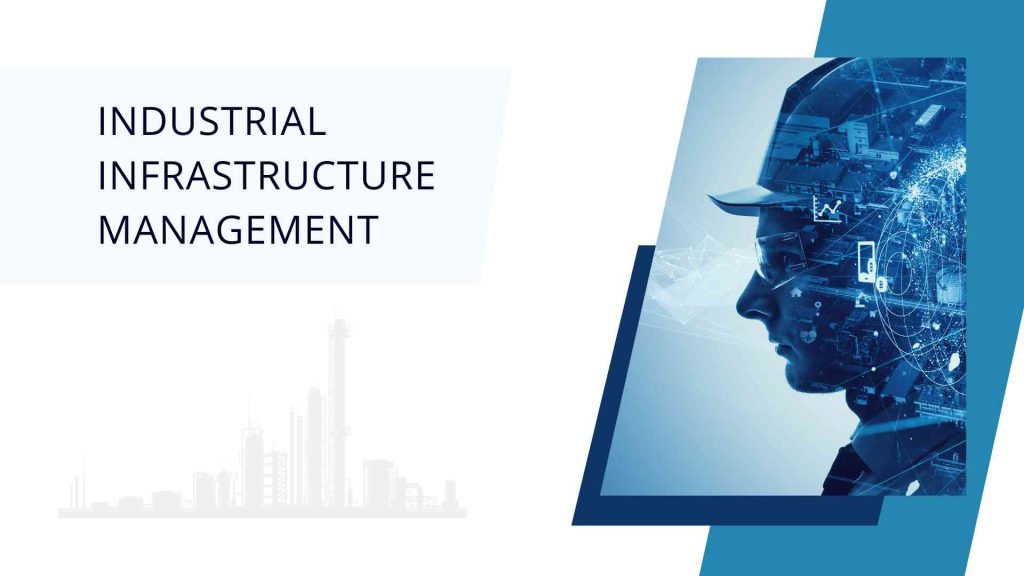Industrial infrastructure management refers to efficiently and effectively overseeing and maintaining the physical assets and facilities within an industrial environment. This management is essential for industrial facilities’ smooth operation, safety, and longevity, including manufacturing plants, warehouses, refineries, and power plants.
Key aspects of industrial infrastructure management
Asset Management:
Tracking, monitoring, and maintaining industrial assets such as machinery, equipment, buildings, and utilities are critical. This involves scheduling routine inspections, preventive maintenance, and repairs to ensure that assets operate efficiently and avoid costly breakdowns.
Maintenance Planning:
Developing maintenance schedules and strategies is vital to minimize downtime and maximize asset lifespan. This includes predictive maintenance, which uses data and analytics to indicate when equipment will likely fall so that maintenance can be performed just in time.
Health and Safety:
Assuring workers’ safety and compliance with safety regulations is a top priority in industrial infrastructure management. This involves regular safety inspections, hazard assessments, and implementing safety protocols and training programs.
Energy Management:
Industrial facilities often consume large amounts of energy. Effective energy management involves monitoring energy usage, identifying opportunities for energy efficiency improvements, and implementing energy-saving measures to reduce operational costs and environmental impact.
Environmental Compliance:
Industrial infrastructure managers must adhere to environmental regulations and standards. This includes monitoring emissions, waste management, and implementing environmental management systems to minimize environmental impact.
Infrastructure Upgrades and Expansion:
Managers must plan and execute infrastructure upgrades or expansions as industrial facilities grow, or technology evolves. This may involve adding new equipment, expanding facilities, or integrating new technologies to improve productivity.
Data and Technology Integration:
Modern industrial infrastructure management often involves using digital tools, sensors, and data analytics to monitor and control various aspects of the operation. This can include the implementation of Industrial Internet of Things (IIoT) solutions for real-time monitoring and predictive maintenance.
Budget and Financial Management:
Industrial infrastructure managers are responsible for budgeting and financial planning. They must allocate resources effectively, justify capital expenditures, and optimize operational costs.
Risk Management:
Identifying and mitigating risks is essential to prevent accidents, production disruptions, and financial losses. This includes assessing operational risks, developing mitigation plans, and implementing contingency plans.
Compliance and Reporting:
Managers must maintain accurate records, documentation, and reporting to demonstrate compliance with various regulatory requirements and industry standards.
Effective industrial infrastructure management ensures the reliability, safety, and competitiveness of industrial operations. It requires a multidisciplinary approach integrating engineering, technology, management, and compliance to optimize asset performance and efficiency.
Examples
Industrial infrastructure management encompasses various activities and processes designed to oversee and maintain the physical assets and facilities within industrial environments. Here are some examples of industrial infrastructure management in multiple industries:
- Manufacturing Plant Maintenance: Managing the maintenance of machinery, equipment, and production lines within a manufacturing facility. This includes regular inspections, preventive maintenance, and repairs to minimize downtime and maintain optimal production levels.
- Power Plant Operations: Overseeing the operation and maintenance of power generation facilities, including monitoring the performance of turbines, boilers, and electrical systems. This also includes managing environmental compliance and safety protocols.
- Oil and Gas Facility Management: Managing the infrastructure of oil refineries, pipelines, and drilling platforms. This involves maintaining pumps, compressors, and storage tanks and ensuring safety and environmental compliance.
- Warehouse and Distribution Center Operations: Managing warehouses’ and distribution centers’ layout, equipment, and systems. This includes optimizing storage space, conveyor systems, and vehicle fleets to enhance efficiency and reduce operational costs.
- Water and Wastewater Treatment Plant Management: Overseeing water treatment plants and facilities. This includes maintaining pumps, filters, chemical dosing systems and ensuring water quality and environmental compliance.
- Agricultural Infrastructure Management: Managing farm equipment, irrigation systems, and storage facilities on agricultural properties. This includes maintaining tractors, harvesters, and grain silos to support crop production.
- Renewable Energy Facility Operations: Managing wind farms, solar power plants, and other renewable energy facilities. This includes monitoring energy production, maintaining wind turbines or solar panels, and ensuring environmental compliance.
These examples illustrate the diversity of industries and facilities that require industrial infrastructure management to ensure safe, efficient, and compliant operations. In each case, effective management practices help optimize asset performance, reduce operational risks, and support the organization’s overall goals.
How Can Acumatica Help?
Acumatica cloud ERP can significantly enhance Industrial Infrastructure Companies by providing a robust and integrated platform for streamlining their complex operations. This ERP system offers real-time visibility into project management, financials, resource allocation, and document management, enabling efficient project planning, cost control, and resource optimization.
With its cloud-based architecture, Acumatica allows for remote access and collaboration, which is crucial for managing projects across diverse geographic locations. It also facilitates compliance and reporting, ensuring that industrial infrastructure projects adhere to regulatory standards and industry best practices.
Furthermore, Acumatica’s scalability and flexibility accommodate the dynamic needs of these companies as they take on diverse projects, making it a valuable tool for achieving operational excellence and sustained growth in the industrial infrastructure sector. Contact us for a customized ERP.

Vijay comes with a vast experience in ERP and enterprise solutions space with about 20 years of experience in various packaged application like Acumatica, SAP, Orion, Salesforce.com, SugarCRM and, SalesLogix.

